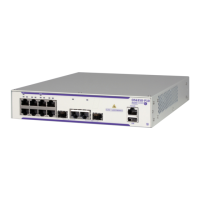AAA Commands
page 43-18 OmniSwitch 6250 CLI Reference Guide November 2009
aaa authentication mac
Enables/Disables the switch for MAC authentication. This type of authentication is available in addition to
802.1x authentication and is designed to handle devices that do not support an 802.1x authentication
method (non-supplicants).
aaa authentication MAC server1 [server2] [server3] [server4]
no aaa authentication MAC
Syntax Definitions
server1 The name of the RADIUS authentication server used for MAC authenti-
cation. (Note that only RADIUS servers are supported for MAC authen-
tication.) At least one server is required. RADIUS server names are set
up through the aaa radius-server command.
server2...server4 The names of backup servers used for MAC authentication. Up to 3
backups may be specified; include a space between each server name.
These backups are only used if server1 becomes unavailable. They are
polled in the order they are listed in this command. The first available
server becomes the authentication server.
Defaults
N/A
Platforms Supported
OmniSwitch 6250
Usage Guidelines
• Up to 4 RADIUS servers (total) may be specified. At least one server is required. Each server name
should be separated by a space.
• Use the no form of this command to disable MAC authentication for the switch.
• The switch uses only the first available server in the list to check for user information. For example, if
server1 is not available, the switch will poll server2. If user information is not found on the first avail-
able server, the authentication request will fail.
• RADIUS servers may each have an additional backup specified through the aaa radius-server
command.
• MAC authentication verifies the source MAC address of a non-supplicant device via a remote
RADIUS server. Similar to 802.1x authentication, this method sends RADIUS frames to the server
with the MAC address embedded in the username and password attributes.
• Note that the same RADIUS servers can be used for 802.1x (supplicant) and MAC (non-supplicant)
authentication. Using different servers for each type of authentication is allowed but not required.
• Use the vlan port 802.1x command to enable or disable ports for 802.1X. Use the 802.1x non-suppli-
cant policy authentication command to configure a MAC authentication policy for a dedicated
802.1X port.

